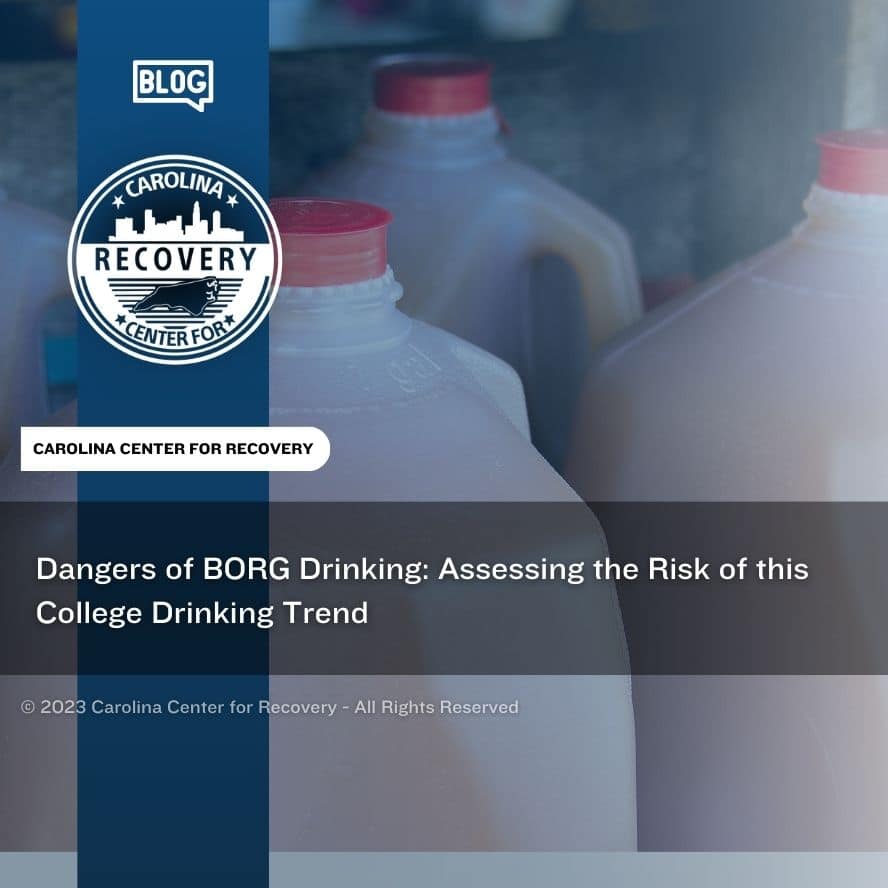Dangers of BORG Drinking: Assessing the Risk of this College Drinking Trend

Medically Verified: 2/1/24
Medical Reviewer
Chief Editor

All of the information on this page has been reviewed and verified by a certified addiction professional.
Alcohol is the most commonly abused substance in the United States. According to the National Institute of Alcohol Abuse and Alcoholism (NIAAA), 78.3% of people aged 12 or older reported drinking at some point in their lifetime.[1]
While occasional alcohol use is fine, some people have a hard time controlling how much they drink. Even further, many young adults consume large amounts of alcohol at once without realizing how dangerous their behavior is. The NIAAA reports that 3.2 million people from the ages of 12 to 20 engaged in binge drinking in the past month, a type of drinking that involves consuming large amounts of alcohol at once.[2]
As if binge drinking was not dangerous enough, a new concerning trend has hit college-aged students. “BORG drinking” is becoming increasingly popular, a trend that involves drinking a large jug of alcohol.
What is BORG Drinking?
Many college students are beginning to partake in a new and dangerous alcohol trend called “BORG drinking.” BORG is an acronym that stands for “blackout rage gallons.” Young adults and even underage teens engage in this “drinking challenge” by creating an alcoholic beverage in a gallon container and drinking it all to themselves.
Oftentimes, BORGs contain vodka and mixers like flavored water and electrolytes. The idea is that the electrolytes will help them prevent hangovers in the morning while also making the drink taste good. Drink mixers and flavoring can nearly mask the taste of alcohol, making it easy for young people to drink huge quantities in a short amount of time.
BORGs have quickly become a social media trend, with people assigning names and characters to their BORGs, such as SpongeBorg Squarepants.
How Much Alcohol is Safe to Drink?
According to the Centers for Disease Control and Prevention (CDC), people should limit their drinking to “2 drinks or less in a day for men or 1 drink or less in a day for women, on days when alcohol is consumed” to reduce the impact of alcohol on your health.[3]
When someone drinks more than the safe amount of alcohol in one sitting, this is considered binge drinking. The National Institutes of Health (NIH) reports that having 5 or more drinks as a male or 4 or more drinks as a female is considered binge drinking.[4]
Keeping this in mind, BORG drinks often include up to a fifth of vodka, which is equivalent to 17 shots. Drinking this much alcohol at once could cause your blood alcohol content to shoot up to 0.30%, which can cause life-threatening problems like alcohol poisoning.[5]
What are the Dangers of BORG Drinking?
While some students say that BORGS make drinking safer because they reduce the risk of being roofied since they are made at home and sealed in a container, BORG drinking can be dangerous. For example, BORGs contain a lot of alcohol and can lead to a life-threatening alcohol overdose. In addition to the risk of overdosing, people who engage in this type of drinking are at risk of developing an alcohol use disorder and significantly damaging their liver due to the high alcohol content in these homemade beverages.
The dangers of BORG drinking include:
Alcoholism
When you drink large amounts of alcohol frequently, your body might begin to rely on it to function properly. As a result, you could develop an alcohol use disorder – otherwise known as alcoholism. Unfortunately, alcoholism requires extensive professional treatment and puts you at risk of other health conditions like severe liver damage.
Alcohol Poisoning
BORG drinking involves drinking a large amount of alcohol at once, sometimes up to 17 shots of liquor. Drinking this much alcohol can cause alcohol poisoning, which is another term for overdose.
The symptoms of alcohol overdose include:[5]
- Mental confusion
- Difficulty remaining conscious
- Vomiting
- Seizures
- Slowed and irregular breathing
- Slowed heart rate
- Clammy skin
- Dulled responses
- Extremely low body temperature
- The bluish tint of the skin and paleness
If you or someone you love is experiencing an alcohol overdose, contact emergency medical services immediately.
Liver Damage
Lastly, drinking from a BORG frequently could significantly damage your liver. Because your liver processes and eliminates alcohol from your system, drinking large amounts could cause it to linger in your liver for an extended period, forcing the organ to work overtime. As a result, you could develop alcoholic fatty liver disease, alcoholic hepatitis, and cirrhosis of the liver.[6]
Find Help for Alcohol Abuse and Alcoholism
If you or a loved one are struggling with an alcohol use disorder, it’s time to get help.
At Carolina Center for Recovery, we offer individualized, extended-term treatment in an intimate setting located in Charlotte, NC. We take a holistic approach to treating addiction, offering a variety of treatment modalities centered around identifying and resolving the underlying issues associated with the addiction. Contact us today for more information on how to get started.
References:
- The National Institute of Alcohol Abuse and Alcoholism (NIAAA): Alcohol Use in the United States, Retrieved November 2023 From https://www.niaaa.nih.gov/alcohols-effects-health/alcohol-topics/alcohol-facts-and-statistics/alcohol-use-united-states-age-groups-and-demographic-characteristics
- The National Institute of Alcohol Abuse and Alcoholism (NIAAA): Underage Drinking in the United States (ages 12 to 20), Retrieved November 2023 From https://www.niaaa.nih.gov/alcohols-effects-health/alcohol-topics/alcohol-facts-and-statistics/underage-drinking-united-states-ages-12-20
- The Centers for Disease Control and Prevention (CDC): Dietary Guidelines for Alcohol, Retrieved November 2023 From https://www.cdc.gov/alcohol/fact-sheets/moderate-drinking.htm
- The National Institutes of Health (NIH): Drinking Levels Defined, Retrieved November 2023 From https://www.niaaa.nih.gov/alcohol-health/overview-alcohol-consumption/moderate-binge-drinking
- The National Institute of Alcohol Abuse and Alcoholism (NIAAA): Understanding the Dangers of Alcohol Overdose, Retrieved November 2023 From https://www.niaaa.nih.gov/publications/brochures-and-fact-sheets/understanding-dangers-of-alcohol-overdose
- The National Institutes of Health (NIH): Alcoholic Liver Disease, Retrieved November 2023 From https://www.ncbi.nlm.nih.gov/pmc/articles/PMC5513682/

